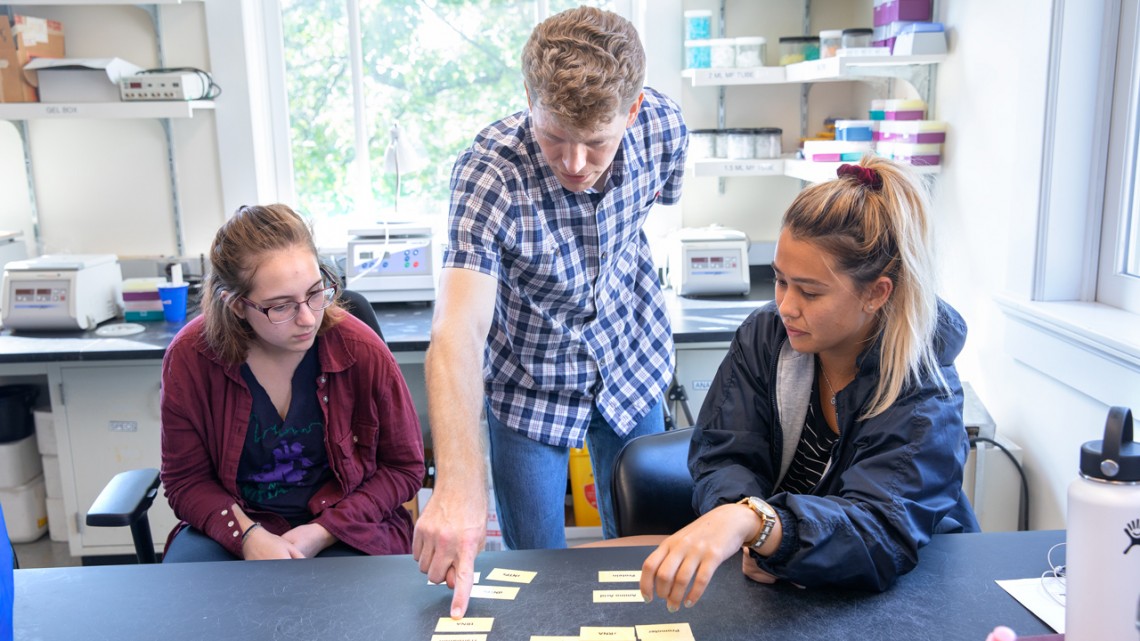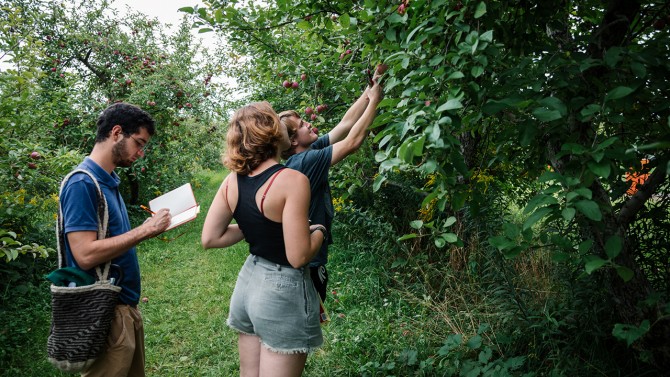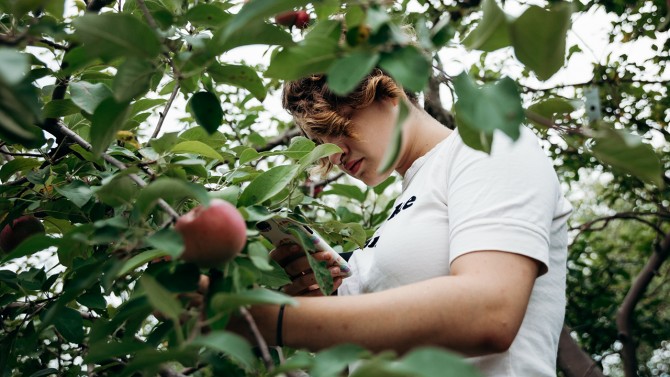
Professor Dan Buckley, center, works with Julia Smith and Chloe Carpenter, both ‘20.
Active learning grants energize CALS classrooms
By Kelsey O’Connor
Jumbled on the classroom tabletop lay cards scrawled with words that, when properly arranged, tell a story: the complicated flow of genetic information in a cell.
Students in the microbiology class broke into small groups and conferred with each other about the best way to organize cards with words like “RNA polymerase,” “start codon,” “mRNA” and “promoter.” When students felt confident they had it right or had a question, they called over an instructor and explained the process in detail.
Chloe Carpenter ’20 said being actively engaged in this way enhanced her ability to understand the subject matter.
“Working with the material in this way is better for your cognition level. It’s learning as you go, so you’re much better prepared for exams,” said Carpenter, a biological sciences and animal science double major.
With support from Alex Hanson ’87 and Laura Finlay Hanson ’87, the Active Learning Initiative (ALI) at Cornell is expanding campuswide, and teaching techniques like these are increasingly being used in classrooms across the university. The active learning techniques align with President Martha E. Pollack’s vision of “education with verve.”
The College of Agriculture and Life Sciences (CALS) is supporting faculty with grant funding that promotes active learning in their classrooms. This academic year, six proposals split $500,000 to help hundreds of students sharpen critical-thinking skills, develop in-the-field experience and become equipped with skills to tackle scientific problems rather than be passive learners. Faculty are shifting emphasis away from the traditional lecture to techniques that use hands-on learning and incorporate student response technologies while dedicating classroom time to problem-solving and engagement.
“Students today are used to having all possible information at their fingertips,” said Kathryn J. Boor ’80, the Ronald P. Lynch Dean of CALS. “As a consequence, universities have to be able to teach them differently than the classic 50-minute lecture. Here at CALS, we are committed to preparing our students to be the problem solvers of tomorrow. With active learning, we are helping students master difficult problems and increase mastery of creative and innovative thinking.”
Research shows that the more students are involved in their own education, the better they learn, said Sue Merkel, associate director of the CALS Office of Academic Programs.
“Memorization is not an optimal learning method,” Merkel said. “What we want to do as educators is to discover how to get students to solve new problems using what they learned. We are dedicated to helping faculty achieve that in their classrooms.”
In the microbiology class taught by Esther Angert, professor in the Department of Microbiology, and Dan Buckley, professor in the Department of Microbiology and the School of Integrative Plant Science (SIPS), students were given reading assignments outside class to learn the flow of information in the cell. Classroom time was dedicated to learning the intricacies of DNA replication, transcription and translation in a more engaged way.
“This is complicated stuff; students often get confused and want to memorize a list of components,” said Buckley. “But it’s not something to be memorized: Cell function is a process, it’s a program.”
“We’ve been developing a lot of active-learning teaching strategies as we try to break students away from memorization,” said Angert.
Students are noticing. “I’m taking more classes that aren’t super lecture-focused,” Carpenter said. “In those old kinds of classes, you go in, try to absorb a bunch of information and then regurgitate it for a test.”
In Biology and Management of Plant Diseases, active learning means getting students out of the lab and lecture hall to local farms. Rather than learn through lecture, students inspect squash, apples and other produce at an operating farm to see actual diseases, pests and problems and interact with growers.
“Our classes focus on plant disease, but what I wanted them to understand from their grower visit is the breadth of the integrated nature of the topic. For growers, diseases are a part of horticulture, plant breeding, entomology; it’s complex and multifaceted,” said Kerik Cox, associate professor in the Plant Pathology and Plant-Microbe Biology Section of SIPS, who co-teaches the course with support specialist Mary McKellar.
Plant science major Isabella Yannuzzi ’20 and others in the class visited the Silver Queen Farm in Trumansburg, New York. Ahead of the trip, students researched common local diseases. Face-to-face with the farmers, students asked about growing practices, the use of pesticides and crop rotation.
“I appreciate it when you get to go out and they let you apply your knowledge yourself; it’s different than reproducing knowledge on a test,” said Yannuzzi. “You get to see the information you’re learning and you actually get to use it.”
Cox said this semester the same amount of lecture material is being presented, but activities have been restructured. Cox and McKellar have strategized ways to get students thinking and applying their knowledge by posing scenarios and real-world examples during class time once dedicated to lecture.
Even small changes in the classroom can have a big impact, Merkel said. Having students talk among themselves, adding polls and questions during lectures, and flipping the classroom – a method for delivering instructional content before class, and using the class time for more active learning – are some strategies faculty have implemented.
McKellar said incorporating more active learning in the classroom is helping students see the bigger picture and the “Why” of what they are learning.
“I think a lot of times students get hung up on the details and forget why they are learning the material,” she said. “It’s not just to memorize. Instead, students are learning the biology of these pathogens to better understand how to manage disease.”
Another course that received an active learning grant, the Investigative Biology Teaching Laboratory, is developing assessments for critical-thinking skills and training for teaching assistants and instructors.
“Many graduate students just want to get up and talk and explain, and so you need to train people to learn how to facilitate learning, to ask questions or to help students discover rather than just tell, tell, tell,” Merkel said.
The universitywide ALI is now accepting grant proposals from departments that want to incorporate active learning strategies. These grants will allow departments to improve significant parts of their undergraduate teaching. Pre-proposals are due Oct. 23. Email Peter Lepage for more information.
Kelsey O’Connor is a freelance writer for the College of Agriculture and Life Sciences.
Media Contact
Get Cornell news delivered right to your inbox.
Subscribe


